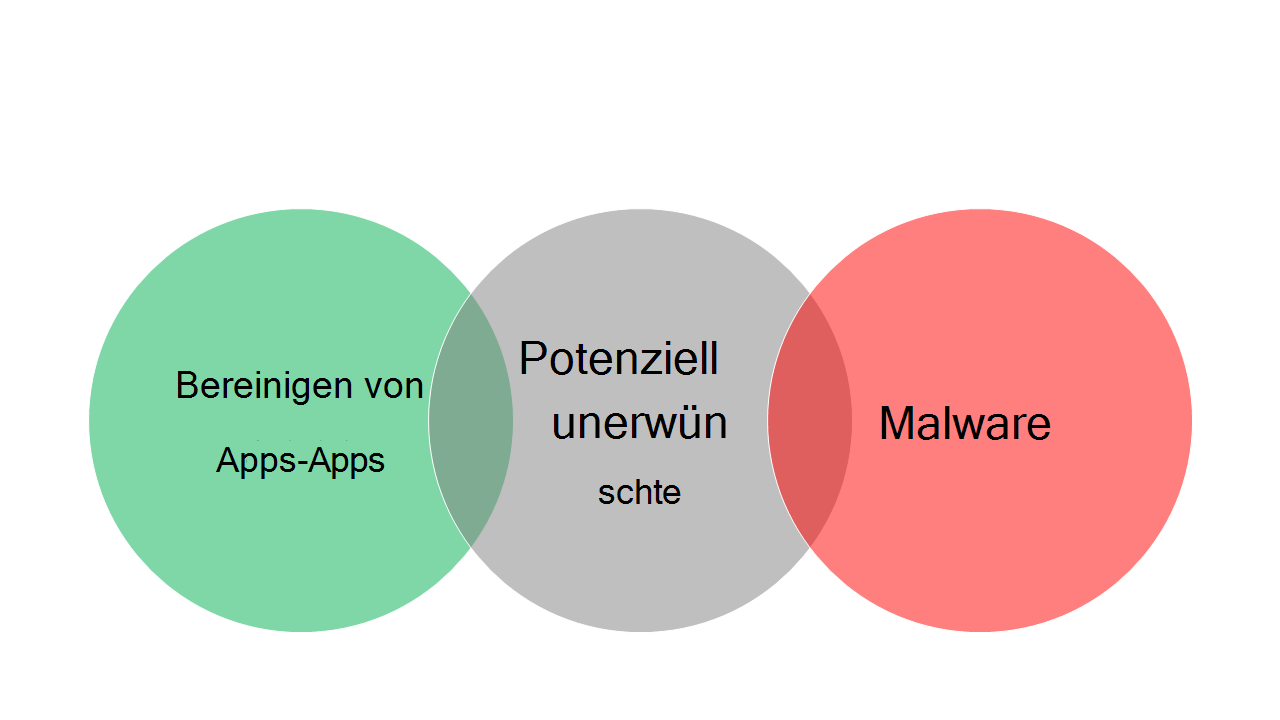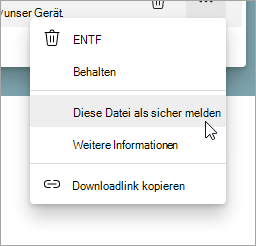Im Software-Bereich gibt es auf der einen Seite saubere Apps und auf der anderen Seite Schadsoftware (Malware), sowie eine Grauzone dazwischen, in die wir wenig Vertrauen haben oder die vielleicht ein beunruhigendes Verhalten zeigt, aber nicht klar als Malware geortet werden können. Wir nennen diese Software im Graubereich „Potenziell unerwünschte Apps“ oder „PUA“.
Schadsoftware ist Schadsoftware. Es könnte sich um ein selbst replizierendes Virus handeln, ein „Trojanisches Pferd“, das vorgibt, etwas zu sein, was es nicht ist, um Sie zur Installation zu verleiten oder eine andere Art von Angriff ausführt. Ihr Ziel besteht möglicherweise darin, Ihre persönlichen Daten zu stehlen, Ihre Identität zu stehlen, Ihr System zu verwenden, um Angriffe gegen andere zu starten oder andere cyberkriminelle Aktivitäten zu begehen. Microsoft Defender Antivirus versucht, Schadsoftware zu blockieren, bevor Sie Ihr Gerät infizieren kann.
Potenziell unerwünschte Apps (PUA) sind keine Malware, aber sie zeigen möglicherweise unerwünschte Werbung an, verwenden Ihren PC insgeheim für das Cryptomining, bieten andere unerwartete Apps an oder tun andere unerwünschte Dinge.
Im Falle von potenziell unerwünschten Apps kann Windows Sie darüber informieren, dass wir Bedenken haben, und Ihnen die Entscheidung überlassen, ob Sie mit der Installation fortfahren möchten oder nicht. Weitere Informationen zum Aktivieren des Schutzes vor potenziell unerwünschten Anwendungen finden Sie unter Schutz Ihres PCs vor unerwünschten Anwendungen.
Weitere Informationen
Weitere Informationen darüber, wie Microsoft Schadsoftware, unerwünschte Software und potenziell unerwünschte Anwendungen klassifiziert, finden Sie unter Wie Microsoft Schadsoftware und potenziell unerwünschte Anwendungen identifiziert.
Reduzieren Sie die Wahrscheinlichkeit, dass Sie unerwünschte Software erhalten
-
Laden Sie Anwendungen nur aus vertrauenswürdigen Quellen wie dem Microsoft Store herunter, und achten Sie darauf, welche Anwendungen Sie installieren.
-
Stellen Sie sicher, dass Sie ein regelmäßig aktualisiertes Antivirusprogramm wie z. B. Microsoft Defender Antivirus ausführen, das in allen modernen Windows-Versionen integriert ist.
-
Windows 11 umfasst smarte App-Steuerung, die Dazu beitragen kann, Ihr Gerät vor potenziell unerwünschten Apps zu schützen.
-
Verwenden Sie einen modernen Browser, wie z. b. den neuen Microsoft Edge. Microsoft Edge verwendet Microsoft Defender SmartScreen, mit dessen Hilfe potenziell unerwünschte Anwendungen blockiert werden können.
-
Halten Sie Ihr Gerät mit den neuesten Updates für Windows, Ihren Browser und Ihre Anwendungen auf dem neuesten Stand.
Tipp: Starten Sie Ihren PC mindestens einmal pro Woche neu. Dies kann zu einem reibungsloseren Ablauf beitragen und sicherstellen, dass die neuesten Updates regelmäßig installiert werden.
Wenn Sie glauben, dass Sie bereits unerwünschten Software installiert haben
-
Deinstallieren Sie nicht benötigte Software über Einstellungen > Apps > Apps & Features (Software in älteren Windows-Versionen).
-
Holen Sie sich in Windows-Sicherheitdie neueste Security Intelligence und führen Sie dann einen vollständigen Scan mit Microsoft Defender Antivirus aus. So wird es gemacht
-
Wenn die unerwünschte Software weiterhin vorhanden ist, können Sie die Dateien an Microsoft übermitteln.
-
Führen Sie eine Offlineüberprüfung mit Microsoft Defender Offline aus.
Wenn Sie in einem Unternehmen arbeiten, finden Sie auf der Website von Microsoft Security Intelligence detaillierte Informationen zu unerwünschter Software.
Einen Download melden, der Ihrer Meinung nach falsch gekennzeichnet wurde
Wenn Sie versuchen, eine Datei in Microsoft Edge herunterzuladen, wird Ihnen möglicherweise eine Warnung angezeigt, dass Edge davon überzeugt ist, dass die Datei böswillig oder ein PUA sein könnte. Wenn Sie sicher sind, dass die Datei sicher ist, könnte diese Warnung ein „falsches positives Ergebnis“ sein. Sie können dies an uns melden, damit wir die Datei überprüfen und sicherstellen können, ob sie sicher ist und in Zukunft nicht blockiert werden sollte.
Um ein falsches positives Ergebnis zu melden, wählen Sie die drei Punkte neben der Download-Alarm aus, und wählen Sie im Menü, das angezeigt wird, die Option Diese Datei als sicher melden aus.












